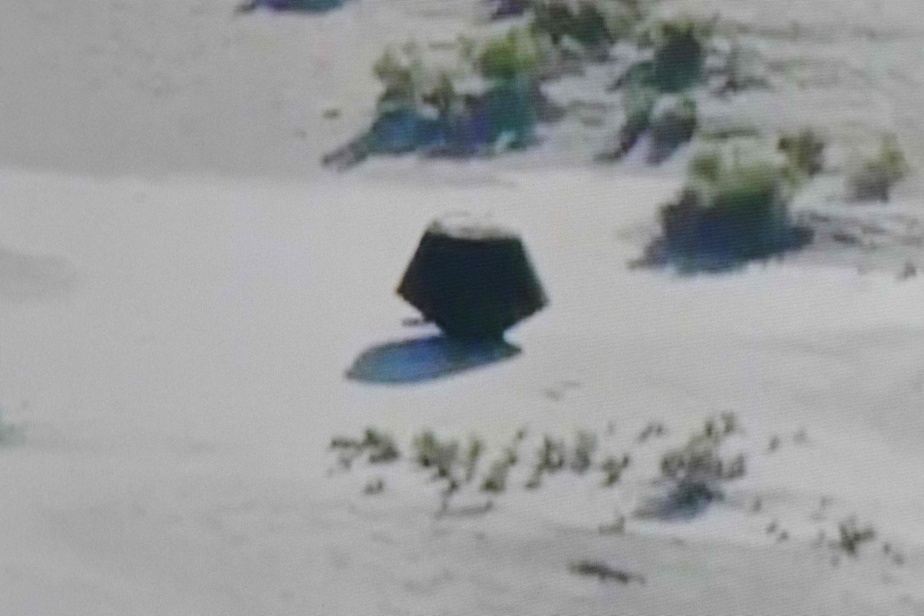(Dugway) The largest asteroid sample ever collected, and the first for NASA, landed in the Utah desert in the United States on Sunday, after a dizzying final descent through the Earth’s atmosphere, seven years after the takeoff of the OSIRIS-REx probe.
The fall, observed by army sensors, had to be slowed by two successive parachutes. The main parachute, however, deployed higher than expected, and the capsule landed slightly earlier than expected, a NASA commentator announced on his live video.
The sample, taken in 2020 from the asteroid Bennu, must contain around 250 grams of material, according to the American space agency’s estimate, much more than the two previous asteroid samples reported by Japanese missions.

PHOTO PHOTO TAKEN FROM THE NASA SITE, VIA THE CANADIAN PRESS
The asteroid Bénou sketched by OSIRIS-REx
It should “help us better understand the types of asteroids that could threaten the Earth”, and shed light on “the very beginning of the history of our solar system”, underlined the boss of the space agency, Bill Nelson.
“The return of this sample is truly historic,” NASA scientist Amy Simon said before the landing. This is the “largest sample we have brought back from lunar rocks” from the Apollo program, concluded in 1972.
The area targeted on the ground was 58 km long by 14 km wide, on a military zone usually used to test missiles.
Approximately four hours before the scheduled landing time, the OSIRIS-REx probe released the capsule containing the sample, more than 100,000 km from Earth (approximately 1/3 of the Earth-Moon distance).
During the last 13 minutes, this capsule crossed the atmosphere: it entered at more than 44,000 km/h, with a temperature rising to 2700°C.
For its part, the probe set off to visit another asteroid.
Two Japanese samples
Once the capsule was on the ground, a team armed with gloves and masks had to ensure its condition, before placing it in a net, then lifted by a helicopter and taken to a temporary “clean room”.

PHOTO PROVIDED BY NASA, VIA AGENCE FRANCE-PRESSE
The NASA team recovering the capsule containing the asteroid sample.
The capsule must be exposed to the sand of the American desert for as short a time as possible, in order to avoid any contamination of the sample which could distort subsequent analyses.
On Monday, it will be flown to the Johnson Space Center in Houston, Texas. This is where the box will be opened, in another airtight room. The process will take days.
NASA is planning a press conference on October 11 to reveal initial results.
The majority of the sample will be preserved for study by future generations. About 25% will be immediately used for experiments, and a small part will be shared with partners Japan and Canada.
Japan itself gave NASA some grains from the asteroid Ryugu, of which it brought back 5.4 grams in 2020, during the Hayabusa-2 mission. In 2010, he reported a microscopic amount from another asteroid.
This time, the Bennu sample is “much bigger, so we will be able to do a lot more analysis,” said Amy Simon.
History of our origin
Asteroids are composed of the original materials of the solar system, 4.5 billion years ago. Unlike Earth, they remained intact.
They therefore hold “clues about how the solar system formed and evolved,” Melissa Morris, head of the OSIRIS-REx program at NASA, said at a press conference. “It is the story of our own origin. »
By hitting our planet, “we think that asteroids and comets brought organic matter, potentially water, that helped life develop on Earth,” explained Amy Simon.
Scientists believe that Bennu (500 meters in diameter) is rich in carbon, and contains water molecules locked in minerals.
The asteroid also surprised scientists: its surface turned out to be less dense than expected during sample collection. The arm of the probe had sunk, a bit like in a ball pit.
However, better understanding its composition could prove useful in the future.
There is a small chance (1 in 2700 chance) that Bennu will hit Earth in 2182, a collision that would be catastrophic. But last year NASA managed to deflect the trajectory of an asteroid by hitting it.
